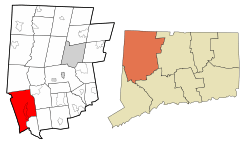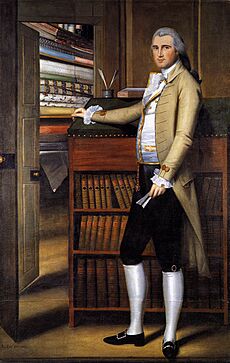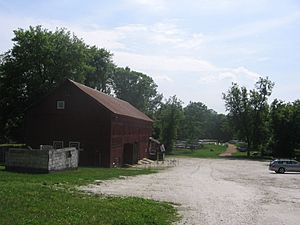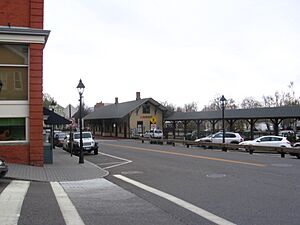New Milford, Connecticut facts for kids
Quick facts for kids
New Milford, Connecticut
Weantinock
|
|||
|---|---|---|---|

The United Bank Building, located in the Center Historic District
|
|||
|
|||
| Motto(s):
"Gateway to Litchfield County"
|
|||
 Litchfield County and Connecticut Litchfield County and Connecticut Western Connecticut Planning Region and Connecticut Western Connecticut Planning Region and Connecticut |
|||
| Country | United States | ||
| U.S. state | Connecticut | ||
| County | Litchfield | ||
| Region | Western CT | ||
| Settled | 1707 | ||
| Incorporated | 1712 | ||
| Government | |||
| • Type | Mayor-council | ||
| Area | |||
| • Total | 63.7 sq mi (165.0 km2) | ||
| • Land | 61.6 sq mi (159.5 km2) | ||
| • Water | 2.1 sq mi (5.5 km2) | ||
| Elevation | 236 ft (72 m) | ||
| Population
(2020)
|
|||
| • Total | 28,115 | ||
| • Density | 457/sq mi (176.3/km2) | ||
| Time zone | UTC-5 (Eastern) | ||
| • Summer (DST) | UTC-4 (Eastern) | ||
| ZIP Codes |
06755, 06776
|
||
| Area code(s) | 860/959 | ||
| FIPS code | 09-52630 | ||
| GNIS feature ID | 209242 | ||
New Milford is a town in Litchfield County, Connecticut, USA. It's part of the larger Greater Danbury area and the New York City region. In 2020, about 28,115 people lived here.
New Milford is located about 14 miles north of Danbury. It sits along the Housatonic River and borders the northeastern side of Candlewood Lake. It's the largest town in Connecticut by land area, covering almost 63.7 square miles (165 square kilometers). The main part of town is known as the town center.
The town is about 50 miles west of Hartford and 63 miles northeast of New York City. New Milford has several smaller areas, like Gaylordsville, Merryall, and Northville. The main roads, U.S. 7 and U.S. 202, run through the town and form its main street.
The land where New Milford is today was first home to the Native American Wawyachtonoc people. English colonists officially started the town in the early 1700s.
Contents
History of New Milford
Early Native American Life
The Wawyachtonoc people were a group connected to the Paugussett Nation. Later, they became linked with the Mahican tribe. They lived in the New Milford area before and during the time of the colonists.
They were farmers and fishers. They grew corn, squash, beans, and tobacco, especially near the Housatonic and Still rivers. They also fished in the freshwater rivers. The Wawyachtonoc spoke an Algonquian language. Their main village, "Weantinock," was close to where New Milford is now, along the Housatonic River.
Colonial Settlement
In 1707, John Noble Sr. and his eight-year-old daughter, Sarah Noble, were the first English settlers. A public school in town was later named after Sarah Noble. Other people who had bought land there soon joined them.
On October 17, 1711, twelve families, totaling about 70 people, asked the Connecticut General Assembly to create a new town. They also wanted the right to collect taxes to support a minister. The legislature approved, and the town was officially formed the next year. The residents soon found Daniel Boardman to be their preacher. He became the minister of the Congregational Church on November 21, 1716.
Most of northwestern Connecticut was placed under New Haven County in 1722. In 1730, the eastern part of northwestern Connecticut moved to Hartford County. But New Milford, Salisbury, and Sharon stayed in New Haven County until Litchfield County was created in 1751.
New Milford and the American Revolution
Roger Sherman lived in New Milford before moving to New Haven in 1761. He became an important member of the Continental Congress. He was one of the people who signed both the Declaration of Independence and the U.S. Constitution. The spot where his old house stood is now where the Town Hall is located.
During the American Revolution, the 7th Connecticut Regiment was formed in New Milford on September 16, 1776. Men from New Milford in this regiment fought in battles like Brandywine, Germantown, and Monmouth. In total, 285 men from the town fought in the war. At that time, the town had a population of 2,776 people.
The Boardman Family's Contributions
The Boardman family was very important in New Milford's history.
- David Sherman Boardman (1768–1864) was a lawyer and later a chief judge in Litchfield County. He was also a judge for the New Milford probate district for 16 years. He was elected to the General Assembly eight times.
- Elijah Boardman (1760–1823) was a U.S. senator for Connecticut. He was born in New Milford and fought in the Revolutionary War.
- William Whiting Boardman (1794–1871) was a U.S. Representative from Connecticut. He was Elijah Boardman's son. He served as a Connecticut state senator and was a member of the Connecticut State House of Representatives many times. He was also the Speaker of the Connecticut State House of Representatives.
Changes in the 1800s and 1900s
In the early to mid-1800s, New Milford had several places that were part of the Underground Railroad. This was a secret network that helped enslaved people find freedom.
Later in the 1800s, many new businesses came to town. Fire companies, telephone and electricity companies, and newspapers were started. Factories in New Milford made buttons, paint, hats, furniture, pottery, and dairy products. Tobacco became a very important crop, and warehouses were built to store and process it.
In 1942, Buck's Rock Camp, a well-known summer camp, was founded. It is still open today. The house that inspired the famous 1946 novel and 1948 movie, Mr. Blandings Builds His Dream House, is still in the Merryall part of town.
New Milford in the 2000s
New Milford has continued to grow and improve. The town built a large sewer plant and a pump station. They also rebuilt the intersection of Route 67 and Grove Street and an ambulance facility.
Many parks and trails have been improved. A skate park was added at Young's Field in 2006. Tennis and basketball courts were rebuilt there in 2010. A basketball court was also rebuilt at Williamson Park in Gaylordsville. Lynn Deming Park was improved in 2017. The town is also working on the New Milford River Trail. This trail will connect to existing trails and greenways in nearby towns. A dog park called Candlewoof Dog Park was completed. A bocce ball court was built at the Senior Center by a Boy Scout troop.
New Milford is a popular place to visit on weekends from April to December. Many people come for the Elephant's Trunk Flea Market. This is a very large outdoor flea market that is said to be the biggest weekly flea market in New England.
The town's population has continued to grow, but at a slower pace since the early 2000s.
Historic Places in New Milford
Several places in New Milford are listed on the National Register of Historic Places. This means they are important historical sites. Some of these include:
- Boardman's Bridge
- Carl F. Schoverling Tobacco Warehouse
- E. A. Wildman & Co. Tobacco Warehouse
- Hine-Buckingham Farms
- Housatonic Railroad Station
- J. S. Halpine Tobacco Warehouse
- John Glover Noble House
- Lover's Leap Bridge
- Merritt Beach & Son Building
- Merryall Union Evangelical Society Chapel
- New Milford Center Historic District
- United Bank Building
Geography and Climate
New Milford is located on the northeastern shore of Candlewood Lake. The East Aspetuck River, Still River, and Housatonic River all flow through the town. Downtown New Milford has a very large town green. It is often called the longest town green in Connecticut.
New Milford covers a total area of about 63.7 square miles (165.1 square kilometers). This makes it the largest town in Connecticut. About 61.6 square miles (159.5 square kilometers) is land, and 2.1 square miles (5.6 square kilometers) is water.
Greater New Milford Area
The Greater New Milford Area is also called Southern Litchfield County. It includes several charming towns in Connecticut's beautiful landscape. These towns are Bridgewater, Kent, New Milford, Roxbury, Sherman, Warren, and Washington. This area is known for its rich history, rural charm, and pretty scenery. People enjoy the historic buildings, lively community life, and a mix of town and country living.
Main Communities in New Milford
New Milford is made up of several smaller communities:
- Gaylordsville
- Boardman Bridge
- Lower Merryall
- Merwinsville
- New Milford Center
- Northville
- Park Lane
- Still River
- Upper Merryall
- Lanesville
- Candlewood Hills
- Sunny Valley
- Pickett District
- Squash Hollow
Climate in New Milford
New Milford has a humid continental climate. This means it has mild to warm, humid summers. Winters are cold to very cold. Rain and snow are spread fairly evenly throughout the year. The highest temperature ever recorded was 103°F (39°C) in July 1966. The lowest was -18°F (-28°C) in January 1968. Snowfall is common in winter.
| Climate data for New Milford, Connecticut (Candlelight Farms Airport) | |||||||||||||
|---|---|---|---|---|---|---|---|---|---|---|---|---|---|
| Month | Jan | Feb | Mar | Apr | May | Jun | Jul | Aug | Sep | Oct | Nov | Dec | Year |
| Record high °F (°C) | 71 (22) |
77 (25) |
87 (31) |
95 (35) |
97 (36) |
100 (38) |
103 (39) |
102 (39) |
100 (38) |
92 (33) |
82 (28) |
76 (24) |
103 (39) |
| Mean daily maximum °F (°C) | 36 (2) |
40 (4) |
49 (9) |
61 (16) |
72 (22) |
80 (27) |
85 (29) |
83 (28) |
75 (24) |
63 (17) |
51 (11) |
40 (4) |
61 (16) |
| Mean daily minimum °F (°C) | 16 (−9) |
19 (−7) |
27 (−3) |
37 (3) |
48 (9) |
56 (13) |
62 (17) |
60 (16) |
53 (12) |
42 (6) |
32 (0) |
22 (−6) |
40 (4) |
| Record low °F (°C) | −18 (−28) |
−14 (−26) |
−8 (−22) |
14 (−10) |
26 (−3) |
36 (2) |
40 (4) |
38 (3) |
28 (−2) |
19 (−7) |
6 (−14) |
−13 (−25) |
−18 (−28) |
| Average precipitation inches (mm) | 3.76 (96) |
3.30 (84) |
4.43 (113) |
4.36 (111) |
4.57 (116) |
4.74 (120) |
4.99 (127) |
4.55 (116) |
4.66 (118) |
4.89 (124) |
4.54 (115) |
4.16 (106) |
52.95 (1,345) |
People of New Milford
| Historical population | ||
|---|---|---|
| Year | Pop. | ±% |
| 1756 | 1,137 | — |
| 1774 | 2,776 | +144.2% |
| 1782 | 3,015 | +8.6% |
| 1790 | 3,167 | +5.0% |
| 1800 | 3,221 | +1.7% |
| 1810 | 3,537 | +9.8% |
| 1820 | 3,830 | +8.3% |
| 1850 | 4,508 | +17.7% |
| 1860 | 3,535 | −21.6% |
| 1870 | 3,586 | +1.4% |
| 1880 | 3,907 | +9.0% |
| 1890 | 3,917 | +0.3% |
| 1900 | 4,804 | +22.6% |
| 1910 | 5,010 | +4.3% |
| 1920 | 4,781 | −4.6% |
| 1930 | 4,700 | −1.7% |
| 1940 | 5,559 | +18.3% |
| 1950 | 5,799 | +4.3% |
| 1960 | 8,318 | +43.4% |
| 1970 | 14,601 | +75.5% |
| 1980 | 19,420 | +33.0% |
| 1990 | 23,629 | +21.7% |
| 2000 | 27,121 | +14.8% |
| 2010 | 28,142 | +3.8% |
| 2020 | 28,115 | −0.1% |
| Population of Connecticut Towns 1756-1820 | ||
In 2020, there were 28,276 people living in New Milford. There were 10,775 households and 7,503 families. The town had about 443.8 people per square mile.
The racial makeup of the town was mostly White (81.6%). There were also Black or African American (4.1%), Asian (3.2%), and Native American (0.1%) residents. About 10.6% of the population was Hispanic or Latino.
In 2000, the average income for a household in New Milford was $65,354. For families, it was $75,775. The income per person was $29,630. About 3.3% of the population lived below the poverty line.
Religious Places

New Milford is home to Faith Church, a large nondenominational church and school. It also has two Catholic churches, a Lutheran church, and a Christian Science community. There is a long-standing Quaker community, a United Church of Christ church, and a United Methodist church. An Assemblies of God (Pentecostal) church is also in town. St. John's Episcopal Church, an Anglican church, is next to the town green. A Jewish Reform synagogue, Temple Sholom, is located near the border with Sherman.
The Canterbury School, a well-known Catholic boarding school, is also near downtown New Milford.
Sports and Activities
New Milford is home to the GMS Rowing Center. This center was started in 2003. It has a successful program for middle and high school students (Juniors). These young rowers compete in national and international events. They have even sent rowers to the Junior World Rowing Championships. In 2011, GMS rowers represented the US at the Under 23 World Championships and the World Rowing Championships.
Education
Elementary Schools
- Northville Elementary School
- Hill & Plain Elementary School
Intermediate Schools
- Sarah Noble Intermediate School
- Schaghticoke Middle School
High Schools
- New Milford High School
Private Schools
- Canterbury School
- The Canterbury School is a well-known Roman Catholic boarding school in New Milford. Its chapel has the Jose M. Ferrer Memorial Carillon, which is a set of bells.
- Faith Preparatory
- Education without Walls
Transportation
New Milford has bus routes provided by the Housatonic Area Regional Transit. The main highways in town are U.S. Route 7 and U.S. Route 202.
There has been talk about improving the Danbury Branch of the Metro-North Railroad. This would extend train service north from Danbury to New Milford. These trains provide service to South Norwalk, Stamford, and Grand Central Terminal in New York City. Currently, the tracks north of Danbury are used for freight by the Housatonic Railroad.
Notable People from New Milford
Many interesting people have lived in New Milford:
- Léonie Fuller Adams (1899–1988), a poetry consultant for the Library of Congress.
- Charles A. Beard (1874–1948), a historian and activist.
- Mary R. Beard (1876–1958), a historian and activist.
- Elizabeth Bentley (1908–1963), a spy.
- David Sherman Boardman (1768–1864), a lawyer, judge, and politician.
- Elijah Boardman (1760–1823), a U.S. senator.
- William Whiting Boardman (1794–1871), a U.S. congressman.
- Emily Sophie Brown (1881–1985), one of the first women in the Connecticut House of Representatives.
- Kenny Coolbeth (born 1977), a motorcycling champion.
- Fortunato Depero (1892–1960), a painter, writer, and sculptor.
- Jack Douglas (1908–1989), a writer.
- Florence Eldridge (1901–1988), a stage and screen actress.
- Diane von Fürstenberg (born 1946), a famous fashion designer.
- Peter Gallagher, an actor.
- Ethan Hawke (born 1970), an actor and writer.
- Lillian Hellman (1905–1984), a playwright.
- Skitch Henderson (1918–2005), a pianist, composer, and conductor.
- Eric Hodgins (1899–1971), an author.
- Ian Hunter (born 1939), an English singer-songwriter.
- Keith Kane, guitarist and founding member of Vertical Horizon.
- Eartha Kitt (1927–2008), a singer, actress, and author.
- Columbia Lancaster (1803–1893), a U.S. congressman.
- Jeremy Levin, a businessman, physician, and scientist.
- Max Lowenthal (1888–1971), a lawyer and civil servant.
- Fredric March (1897–1975), a film and stage actor.
- Florence Maybrick (1862–1941), known for prison reform.
- Seth Meyers, a comedian and television host.
- Hap Moran (1901–1994), a football player.
- Dhan Gopal Mukerji (1890–1936), a writer who won the Newbery Medal.
- William H. Noble (1788–1850), a U.S. congressman.
- M. Scott Peck (1936–2005), a psychiatrist and author.
- Natacha Rambova (1897–1966), a designer, dancer, and actress.
- Thomas Riley, a US ambassador.
- Joan Rivers (1933–2014), a comedian and actress.
- Roger Sherman (1721–1793), a signer of the Declaration of Independence and the U.S. Constitution.
- Jean Simmons (1929–2010), a British actress.
- Eric Sloane (1905–1985), an artist.
- Walker Todd (1786–1840), a lawyer and politician.
- Solmous Wakeley (1794–1867), an early Wisconsin legislator.
- Mary B. Weaver (1887–1978), a Connecticut politician.
- Joseph J. Went (born 1930), a general.
- Horace Wheaton (1803–1882), a U.S. congressman.
- Theodore White (1915–1986), a political author.
- Courtney Savino (born 1998), a singer-songwriter and producer.
Movies Filmed in New Milford
Several movies have been filmed in New Milford:
- The Brass Ring (1983) (TV movie)
- Mr. Deeds (2002)
- Zero Day (2003)
- What Alice Found (2003)
- The Ballad of Jack and Rose (2005)
- The Six Wives of Henry LeFay (2007)
- The Private Lives of Pippa Lee (2009)
- 25/8 (later renamed My Soul to Take) (2009)
- Candlewood (2022)
Images for kids
See also
 In Spanish: New Milford (Connecticut) para niños
In Spanish: New Milford (Connecticut) para niños











